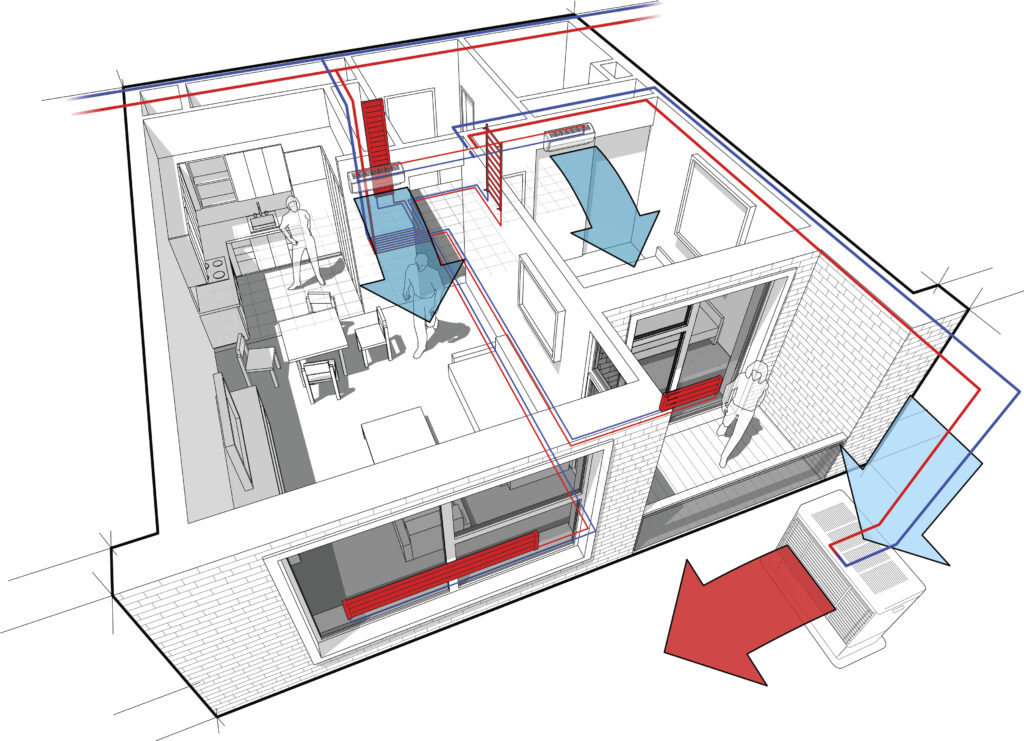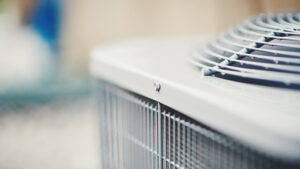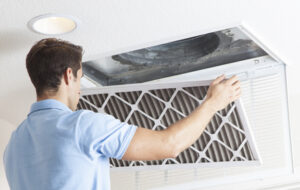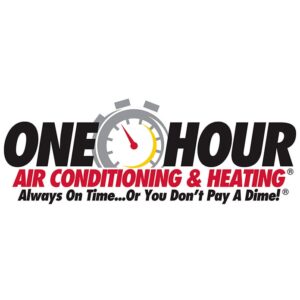
Parts of a Residential HVAC System: A Homeowner’s Guide
Have you ever wondered how your HVAC system keeps your home so comfortable year-round? Whether you’re basking in warmth during the chilly months or enjoying a cool breeze in the heat of summer, it’s all thanks to your residential HVAC system.
But what makes up this essential home system?
In this article, we’ll dive deep into the parts of a residential HVAC system, exploring each component’s role and how they work together to provide you with a comfortable living environment. You’ll gain insights into maintaining and optimizing your system for efficiency and longevity.

A Detailed Explanation of the Parts of a Residential HVAC System
Your HVAC system is more than just a source of comfort; it’s a complex assembly of parts working in harmony.
Let’s break down these parts of a residential HVAC system and understand their functions:

The Thermostat: Your HVAC’s Command Center
The Role of the Thermostat in Your HVAC System
The thermostat (one of the parts of a residential HVAC system) isn’t just a panel on the wall that you adjust to set your desired temperature; it’s the brain of your HVAC system. This device plays a pivotal role in ensuring your home’s comfort by regulating the temperature to match your preferences.
When you set a temperature, the thermostat measures the current room temperature and activates the HVAC system to either heat or cool your home until it reaches your set point.
How Thermostats Maintain Comfort and Efficiency
Modern thermostats, especially smart thermostats, go beyond basic temperature adjustments. They can learn your schedule and preferences, making automatic adjustments to save energy while ensuring your home is comfortable when you’re there.
By effectively communicating with the parts of your residential HVAC system, thermostats help maintain an ideal living environment and can significantly reduce energy consumption, leading to lower utility bills.
Types of Thermostats and Their Features
There are various types of thermostats available, each offering different features:
Manual Thermostats
These are the most basic types, allowing you to set the temperature manually. While they are simple to use, they don’t offer the same energy savings as more advanced models.
Programmable Thermostats
These allow you to set different temperatures for different times of the day and days of the week.
By aligning your HVAC system’s operation with your schedule, you can ensure comfort while maximizing energy efficiency.
Smart Thermostats
The most advanced type, smart thermostats, offer Wi-Fi connectivity, allowing you to control your HVAC system remotely via a smartphone app.
They can learn your habits over time, make automatic adjustments, show your energy consumption in real time, and even provide maintenance reminders.
The Importance of Thermostat Placement
The location of your thermostat (parts of a residential HVAC system) can significantly impact its performance and your HVAC system’s efficiency. It should be placed away from direct sunlight, drafts, doorways, windows, and any heat sources to accurately measure your home’s average temperature.
Proper placement ensures that the parts of your residential HVAC system work harmoniously, providing optimal comfort and efficiency.
By understanding the critical role of the thermostat in your HVAC system, you can make informed decisions about its maintenance, upgrade, and usage, ensuring your home remains a comfortable sanctuary regardless of the season.
The Furnace: The Powerhouse of Warmth
Understanding the Furnace in Your HVAC System
The furnace is a critical component of your HVAC system, especially during the chilly months. It’s responsible for generating heat by burning fuel (such as natural gas, oil, or propane) or using electricity.
This heat is then distributed throughout your home to maintain a warm and comfortable environment. Understanding how your furnace (parts of a residential HVAC system) operates can help you ensure it runs efficiently and effectively.
Types of Furnaces and How They Work
Gas Furnaces
These are among the most common types, using natural gas to fuel the heating process. They are known for their efficiency and the ability to produce a significant amount of heat.
Electric Furnaces
Electric furnaces use heating elements to warm the air, which is then circulated throughout your home. While they can be more expensive to operate due to electricity costs, they are typically cheaper to install and maintain.
Oil Furnaces
Less common in some areas, oil furnaces operate similarly to gas furnaces but use oil as a fuel source. They require a storage tank and regular refills.
Each type of furnace has its unique features and benefits, and the choice often depends on your location, access to fuel sources, and personal preferences.
Maintaining Your Furnace for Optimal Performance
Regular maintenance is crucial to keep your furnace running efficiently. This includes checking the burner, heat exchanger, and blower motor.
Ensuring these parts of a residential HVAC system are in good condition can prevent costly repairs and extend the life of your furnace. Additionally, replacing filters regularly and ensuring that your ductwork is clean and unobstructed can improve your system’s efficiency and your home’s air quality.
The Role of the Furnace in Energy Efficiency
The efficiency of your furnace directly impacts your energy bills and environmental footprint.
Modern furnaces are designed to be much more energy-efficient than older models, with some achieving up to 98% efficiency. This means they convert almost all the fuel to useful heat for your home.
Upgrading to a high-efficiency furnace can be a wise investment, reducing your energy consumption and saving money in the long run.
The furnace is a vital component of your HVAC system, playing a key role in keeping your home warm during the colder months.
Understanding the different types of furnaces, their operation, and the importance of maintenance can help you make informed decisions about your home’s heating, ensuring comfort and efficiency throughout the winter season.
The Air Conditioner: Your Refuge from the Heat
The Crucial Role of the Air Conditioner in Your HVAC System
The air conditioner is one of the indispensable parts of a residential HVAC system, providing much-needed relief during the hot and humid months.
It operates on the principle of heat exchange, removing warm air from your home and releasing it outside, thereby cooling the indoor environment.
Understanding how your air conditioner works can help you maintain it properly, ensuring it keeps your home cool and comfortable when you need it most.
How Air Conditioners Cool Your Home
Air conditioners consist of several key components that work together to cool your home:
Evaporator Coil
Located inside the house, this coil contains a refrigerant that absorbs heat from the indoor air, cooling it down.
Condenser Coil
Situated outside, it releases the absorbed heat into the outdoor air.
Compressor
This component circulates the refrigerant between the evaporator and condenser coils.
Expansion Valve
It regulates the flow of refrigerant into the evaporator coil.
By understanding these components and their functions, you can better appreciate how your air conditioner maintains a comfortable temperature in your home.
Types of Air Conditioners
There are various types of air conditioners, each suited to different needs and spaces:
Central Air Conditioners
These are ideal for cooling multiple rooms or an entire house, providing consistent temperature control.
Window Air Conditioners
A compact solution for cooling single rooms, easy to install and relatively affordable.
Portable Air Conditioners
Flexible and movable, these units can be placed in different rooms as needed.
Ductless Mini-Split Systems
Offering a balance between central and window air conditioners, these systems provide targeted cooling without the need for ductwork.
Maintaining Your Air Conditioner for Efficiency and Longevity
Regular maintenance is key to keeping your air conditioner (parts of a residential HVAC system) running efficiently. This includes cleaning or replacing filters, checking refrigerant levels, and ensuring the condenser coil is free from debris.
Professional servicing of parts of a residential HVAC system can also identify and address potential issues before they lead to costly repairs or system failure.
The Impact of Air Conditioning on Energy Consumption
While air conditioners are essential for comfort, they can be significant energy consumers.
Choosing energy-efficient models and practicing smart usage—such as adjusting thermostats, using programmable settings, and ensuring proper insulation—can mitigate energy usage without compromising comfort.
The air conditioner is one of the parts of a residential HVAC system, especially during the warmer months.
By understanding its operation, types, and maintenance needs, you can ensure your air conditioner provides efficient and effective cooling, keeping your home a comfortable sanctuary against the heat.

The Ductwork: The Circulatory System of Your HVAC
The Vital Role of Ductwork in HVAC Efficiency
Ductwork might not be the most visible part of your HVAC system, but it plays a crucial role in distributing heated or cooled air throughout your home.
Think of ductwork as the circulatory system of your HVAC, ensuring that every room reaches the desired temperature efficiently. Properly designed, installed, and maintained ductwork is key to maximizing comfort and minimizing energy costs.
Understanding the Components of Your Ductwork
Ductwork consists of a series of tubes that transport air from your HVAC system to various parts of your home.
These tubes can be made from different materials, including metal, fiberglass, or flexible plastic. The system includes supply ducts, which deliver conditioned air to rooms, and return ducts, which bring air back to the HVAC system for reconditioning.
The Importance of Ductwork Design
The design of your ductwork (parts of a residential HVAC system) significantly impacts the efficiency of your HVAC.
Poorly designed ductwork can lead to uneven heating or cooling, increased energy consumption, and added strain on your HVAC system. A well-designed ductwork system ensures balanced airflow, maintains consistent temperatures throughout your home, and operates quietly and efficiently.
Maintaining Your Ductwork for Optimal Performance
Regular maintenance is essential to keep your ductwork functioning properly. This includes sealing leaks, insulating ducts to prevent energy loss, and cleaning to remove dust and debris.
Leaky or dirty ductwork can significantly reduce your HVAC system’s efficiency, leading to higher energy bills and reduced comfort.
Signs Your Ductwork May Need Attention
- Uneven temperatures in different rooms
- Noticeable dust buildup around vents
- Increased energy bills without a corresponding increase in usage
- Unusual noises from the ductwork
If you experience any of these issues, it may be time to have your ductwork inspected by parts of a residential HVAC system professional. They can identify and rectify any problems, ensuring your HVAC system operates at peak efficiency.
Also read: QUICK REPAIR FOR AIR CONDITIONER FIXES GUIDE
The Impact of Ductwork on Indoor Air Quality
Your ductwork (parts of a residential HVAC system) can also affect the air quality in your home. Contaminants like dust, pollen, and mold can accumulate in the ducts and be distributed throughout your home.
Regular cleaning and maintenance of your ductwork can help improve indoor air quality, creating a healthier living environment.
The ductwork is a vital component of your residential HVAC system, playing a key role in distributing air efficiently and maintaining comfort in your home.
Understanding its importance, ensuring proper design and installation, and committing to regular maintenance can significantly enhance the performance and efficiency of your HVAC system.
The Vents: Gateways to Comfort in Your Home
The Critical Role of Vents in HVAC Systems
Vents, often overlooked, are fundamental parts of a residential HVAC system, serving as the final gateways through which heated or cooled air enters your living spaces.
Positioned strategically throughout your home, vents are directly connected to the ductwork, ensuring that the air your HVAC system conditions is effectively distributed. Their design and placement significantly influence the overall comfort and efficiency of your HVAC system.
Types of Vents and Their Functions
There are primarily two types of vents in a typical residential HVAC system:
Supply Vents
These are responsible for delivering conditioned air into rooms. They are typically covered with grilles or registers that can be adjusted to control the flow of air.
Return Vents
These vents draw air from your home back into the HVAC system for reconditioning. They are crucial for maintaining consistent air pressure and quality within the ductwork.
Understanding the distinct roles of these vents can help you optimize your HVAC system’s performance and your home’s comfort levels.
Optimizing Airflow Through Proper Vent Management
The efficiency of your HVAC system is partly dependent on how well air is distributed through the vents.
Here are some tips to ensure optimal airflow:
- Avoid blocking vents with furniture, curtains, or rugs, as this can restrict airflow and cause your system to work harder.
- Regularly clean vents to remove dust and debris that can impede air circulation.
- Consider the use of vent deflectors to direct air away from windows or into under-served areas of a room for more even temperature distribution.
The Impact of Vents on Energy Efficiency
Properly maintained and strategically placed vents (parts of a residential HVAC system) can contribute significantly to the energy efficiency of your HVAC system.
By ensuring that air is evenly distributed throughout your home, you can prevent hot or cold spots, reducing the need for your system to overcompensate and consume more energy.
Vents and Indoor Air Quality
Vents also play a crucial role in maintaining good indoor air quality. They facilitate the circulation of air, helping to distribute and filter out pollutants.
Keeping your vents clean is essential to prevent the recirculation of dust, allergens, and other airborne particles, contributing to a healthier indoor environment.
While vents might seem like simple parts of a residential HVAC system, they are vital to the functionality and efficiency of your HVAC system.
Proper care, maintenance, and strategic placement of vents can enhance the comfort of your home, improve energy efficiency, and contribute to better indoor air quality. Understanding and attending to your vents can make a significant difference in the overall performance of your residential HVAC system.
Also read: COMPONENTS OF HVAC SYSTEM RESIDENTIAL: REVITALIZE YOUR HOME
The Heat Exchanger: The Heart of Your Heating System
Understanding the Heat Exchanger in Your HVAC System
The heat exchanger in your furnace is a critical component, often considered the heart of the heating system. It’s where the air is heated before being distributed throughout your home.
Understanding its function and importance can help you appreciate the complexity of parts of a residential HVAC system and the necessity of regular maintenance to ensure its efficiency and safety.
How the Heat Exchanger Works
The heat exchanger (parts of a residential HVAC system) is typically made of metal and has a series of tubes or coils that the combustion gasses pass through.
As these gasses flow through the exchanger, the metal heats up. The furnace’s blower then pushes air across the heat exchanger, warming the air before it is circulated through the ductwork into your living spaces. This process is crucial for efficiently heating your home while keeping the combustion process separate from the breathable air inside your home.
The Importance of Heat Exchanger Integrity
The integrity of the heat exchanger is vital for two main reasons:
Efficiency
A well-functioning heat exchanger ensures that the maximum amount of heat is transferred to the air, improving your furnace’s efficiency and helping to keep energy costs down.
Safety
If the heat exchanger is cracked or damaged, it can allow combustion gasses, including carbon monoxide, to mix with the circulated air, posing serious health risks to the occupants of the home.
Maintaining Your Heat Exchanger
Regular inspections and maintenance are crucial to ensure the heat exchanger is functioning correctly and safely.
Parts of a residential HVAC system professionals can check for signs of wear, corrosion, or damage during routine maintenance visits and address any issues before they become serious problems.
Signs of Heat Exchanger Problems
Be aware of signs that might indicate issues with your heat exchanger, including:
- Unusual smells coming from the furnace, which could indicate gas leaks.
- An increase in soot or other combustion byproducts around the furnace.
- Physical symptoms of carbon monoxide exposure, such as headaches, dizziness, or nausea, when the furnace is running.
If you notice any of these signs, it’s crucial to turn off your furnace and contact parts of a residential HVAC system professional immediately.
Enhancing the Lifespan of Your Heat Exchanger
To extend the lifespan of your heat exchanger (parts of a residential HVAC system) and ensure it operates efficiently, adhere to a regular maintenance schedule, ensure proper furnace installation and operation, and replace the furnace filter regularly to maintain good airflow.
The heat exchanger is a pivotal component of your furnace, playing a crucial role in heating your home safely and efficiently.
Regular maintenance and awareness of potential issues can help ensure that your heat exchanger, and your entire HVAC system, continue to operate effectively, providing comfort and safety for your home.
The Evaporator Coil: Essential for Cooling Your Home
The Role of the Evaporator Coil in Your Air Conditioning System
The evaporator coil (part of a residential HVAC system) is a fundamental component of your air conditioner, playing a pivotal role in the cooling process.
Located in the indoor unit of your AC system, this coil is where the refrigerant absorbs heat from the indoor air, initiating the cooling process that results in a comfortable indoor environment during hot weather.
How the Evaporator Coil Functions
The evaporator coil works in conjunction with the refrigerant, a substance designed to absorb heat efficiently.
As warm air from your home passes over the cold, refrigerant-filled coils, the refrigerant absorbs the heat, cooling the air. This cooled air is then circulated back into your living spaces, reducing the indoor temperature to your desired comfort level.
Maintaining Your Evaporator Coil for Optimal Performance
To ensure your air conditioner operates efficiently and effectively, it’s crucial to maintain the evaporator coil properly.
A clean and well-maintained coil (parts of a residential HVAC system) facilitates better heat absorption, improving the cooling efficiency of your AC system. Regular maintenance includes:
- Cleaning the coil to remove dirt, dust, and other debris that can hinder its ability to absorb heat.
- Checking for and repairing any leaks in the coil, as a refrigerant leak can significantly reduce cooling efficiency.
- Ensuring that the air filter is clean to maintain proper airflow over the coil.
Signs of Evaporator Coil Issues
Be aware of signs that may indicate problems with your evaporator coil, such as:
- Reduced cooling efficiency, resulting in your AC system struggling to maintain the desired temperature.
- Ice buildup on the coil can occur if the coil is dirty or if there are airflow issues.
- Unusual noises from the indoor unit could indicate airflow problems or other issues affecting the coil.
The Impact of the Evaporator Coil on Energy Efficiency
The condition of the evaporator coil directly influences the energy efficiency of your air conditioning system.
A clean and well-functioning coil ensures that the refrigerant can absorb and release heat effectively, reducing the workload on your AC system and potentially lowering your energy bills.
The evaporator coil is a critical component of your air conditioning system, essential for providing effective cooling in your home.
Regular maintenance and prompt attention to any issues can help ensure that your evaporator coil, and your entire AC system, operate efficiently, keeping your home comfortable and your energy costs in check.
The Condensing Unit: Releasing Heat to Keep You Cool
The Integral Role of the Condensing Unit in Air Conditioning
The condensing unit, typically situated outside your home, is one of the parts of a residential HVAC system.
It plays a vital role in the heat exchange process, releasing the absorbed heat from your home’s indoor air into the outdoor environment. This process is essential for the cooling cycle of your air conditioner, ensuring that your indoor spaces remain comfortable even during the hottest days.
Components of the Condensing Unit
The condensing unit houses several key components that work together to expel heat:
The Compressor
This pumps the refrigerant through the system, raising its pressure and temperature so it can release heat effectively in the condenser coil.
The Condenser Coil
Here, the hot, pressurized refrigerant releases its heat to the outdoors, cooling down as it transforms from a gas to a liquid.
The Fan
This component blows outdoor air through the condenser coil, facilitating the heat release process and helping the refrigerant cool more efficiently.
Understanding these components can help you appreciate how your air conditioning system manages to keep your home cool.
Maintaining the Condensing Unit for Efficiency
Proper maintenance of the condensing unit (parts of a residential HVAC system) is essential for the efficient operation of your air conditioning system. Here are some tips to ensure your condensing unit remains in good working order:
- Keep the area around the unit clear of debris, plants, and other obstructions to ensure adequate airflow.
- Regularly inspect the unit for signs of damage, such as bent coil fins or leaks.
- Schedule professional maintenance to check the refrigerant levels, electrical connections, and overall system performance.
Signs of Condensing Unit Issues
Be vigilant for signs that your condensing unit may need attention, including:
- Unusual noises, which could indicate a problem with the fan or compressor.
- Poor cooling performance, suggesting the unit may not be expelling heat effectively.
- Ice buildup on the condenser coil can be a sign of airflow issues or refrigerant problems.
The Impact of the Condensing Unit on Your Comfort and Energy Bills
The efficiency of the condensing unit directly affects your home’s cooling efficiency and, consequently, your energy bills.
A well-maintained unit ensures that heat is effectively expelled from your home, allowing your air conditioner to cool your indoor spaces more efficiently and use less energy in the process.
The condensing unit is a pivotal component of your air conditioning system, playing a key role in releasing heat to keep your indoor environment comfortable.
Regular maintenance and prompt attention to any issues can help ensure that your condensing unit, and your entire air conditioning system, operate efficiently, providing effective cooling while keeping energy costs in check.
The Refrigerant: The Lifeblood of Your Air Conditioning System
Understanding the Role of Refrigerant in HVAC Systems
Refrigerant (parts of a residential HVAC system) is the essential fluid that circulates through your air conditioner, playing a pivotal role in the heat exchange process that cools your home.
This substance absorbs heat from the indoor air and releases it outdoors, a cycle that is fundamental to the cooling function of your HVAC system. Without refrigerant, your air conditioner would not be able to provide the comfort you rely on during warm weather.
How Refrigerant Works in Your Air Conditioner
The refrigerant cycle is a continuous, closed-loop process involving several key steps:
Evaporation
Inside the evaporator coil, the refrigerant absorbs heat from the indoor air, causing it to evaporate and transform from a liquid to a gas.
Compression
The gaseous refrigerant is then compressed by the compressor, increasing its temperature and pressure.
Condensation
The hot, pressurized refrigerant moves to the condenser unit, where it releases the absorbed heat to the outdoor air, condensing it back into a liquid.
Expansion
The refrigerant then passes through an expansion valve, reducing its pressure and temperature before returning to the evaporator coil to repeat the cycle.
Types of Refrigerants and Environmental Impact
Over the years, various types of refrigerants have been used in air conditioning systems, each with its own properties and environmental impacts.
Older refrigerants, such as R-22, have been phased out due to their harmful effects on the ozone layer. Modern air conditioners typically use more environmentally friendly refrigerants, like R-410A, which do not deplete the ozone layer.
Maintaining Proper Refrigerant Levels
Maintaining the correct refrigerant level is crucial for your air conditioner’s efficiency and performance. Too little or too much refrigerant can lead to reduced cooling efficiency, higher energy consumption, and potential damage to the compressor.
Signs of refrigerant issues include:
- Inadequate cooling or uneven temperatures throughout your home.
- Ice buildup on the evaporator coil.
- Hissing or bubbling noises from the refrigerant lines.
If you suspect your system has a refrigerant leak or requires a recharge, it’s essential to contact a professional HVAC technician. Handling refrigerant requires specialized training and equipment due to its chemical properties and the environmental regulations governing its use.
The Importance of Choosing the Right Refrigerant
When installing a new air conditioner or servicing an existing one, choosing the correct type of refrigerant is crucial. It must be compatible with your system to ensure optimal performance and to comply with environmental regulations.
Always rely on qualified HVAC professionals to handle refrigerant-related tasks, ensuring your system’s efficiency and longevity.
Refrigerant is a vital component of your air conditioning system, enabling the heat exchange process that keeps your home cool and comfortable.
Understanding its role, ensuring proper maintenance, and addressing any issues promptly can help maximize your air conditioner’s efficiency and extend its lifespan, ensuring reliable cooling performance for years to come.
The Blower Motor: Ensuring Efficient Air Circulation in Your HVAC System
Central Role of the Blower Motor in HVAC Operations
The blower motor is one of the pivotal parts of a residential HVAC system, playing a crucial role in air circulation.
It powers the fan that moves air through the furnace, across the heat exchanger, and then through the ductwork to various parts of your home. This process is essential for distributing heated or cooled air evenly throughout your living spaces, ensuring consistent comfort in every room.
How the Blower Motor Enhances HVAC Efficiency
Efficient heat distribution in your home hinges on the effective operation of the blower motor.
By ensuring a steady and controlled flow of air, the blower motor facilitates optimal performance of the furnace and air conditioning units.
This not only helps in maintaining the desired temperature but also contributes to the overall energy efficiency of the HVAC system, reducing unnecessary strain and prolonging the lifespan of other components.
Maintaining Your Blower Motor for Optimal Performance
Regular maintenance is key to keeping the blower motor functioning effectively. This includes checking for any signs of wear or damage, ensuring that the motor is clean, and verifying that it’s properly lubricated.
A well-maintained blower motor operates more quietly and efficiently, which can significantly impact your HVAC system’s performance and your home’s comfort levels.
Signs of Blower Motor Issues
Being aware of the signs that indicate a problem with the blower motor can help you address issues before they escalate. These signs include:
- Unusual noises during operation, such as screeching, which may indicate a belt problem, or banging, which could suggest an internal fault.
- Weak airflow from the vents can signal a problem with the motor or related components.
- Overheating may cause the HVAC system to shut down to prevent damage.
The Impact of the Blower Motor on Indoor Air Quality
The blower motor’s role extends beyond temperature control; it also influences indoor air quality.
By ensuring efficient circulation, the blower motor helps distribute filtered air throughout your home, reducing the accumulation of dust, allergens, and other airborne particles. Regularly maintaining the blower motor and associated air filters can significantly improve the air quality in your home, contributing to a healthier living environment.
The blower motor is one of the critical parts of a residential HVAC system, essential for the effective distribution of heated or cooled air throughout your home.
Understanding its function, ensuring regular maintenance, and being vigilant about potential issues can enhance your HVAC system’s efficiency, prolong its lifespan, and maintain a comfortable and healthy indoor environment.
Top 5 Best Practices Related To Parts Of Residential HVAC Systems
-
Schedule Professional HVAC Preventative Maintenance
Regular professional maintenance is crucial for the longevity and efficiency of your HVAC system.
Parts of a residential HVAC system technicians will inspect, service, and troubleshoot your system to prevent breakdowns and ensure it operates efficiently. This includes checking thermostat settings, tightening electrical connections, lubricating moving parts, and cleaning coils.
-
Change the Filters Regularly
Changing your HVAC filters (parts of a residential HVAC system) every 30 days can significantly improve air quality and system efficiency.
Clean filters allow better airflow, enabling the system to heat and cool more efficiently. This simple step can lead to a balance between filtration ability and maximum airflow, enhancing the system’s performance.
-
Perform a Visual Inspection of the HVAC System
Monthly inspections can help identify potential issues in parts of a residential HVAC system early. Check the thermostat, indoor and outdoor units, and all registers and returns.
Ensuring all parts of a residential HVAC system are in order can prevent minor issues from turning into major problems.
-
Keep the Outside Unit Clean and Clear
The external HVAC unit should be free from debris, leaves, and other obstructions. Maintaining clear surroundings ensures proper airflow and system efficiency. Regular cleaning and trimming plants around the unit can prevent airflow blockages and system inefficiencies.
-
Regulate Your Home Temperature
Using a programmable thermostat (parts of a residential HVAC system) to adjust the temperature when you’re not home or sleeping can reduce the system’s workload, extend its lifespan, and decrease energy consumption. Setting comfortable temperatures and reducing system use during off-peak hours can lead to significant energy savings.
These strategies can help homeowners maintain their HVAC systems efficiently, ensuring comfort and energy savings throughout the year.
One Hour Air Conditioning & Heating of Dallas: Your Partner in Parts of a Residential HVAC System Care
Expertise in Residential HVAC Systems
One Hour Air Conditioning & Heating of Dallas stands out as a trusted partner for homeowners looking to maintain, repair, or upgrade their residential HVAC systems.
With parts of a residential HVAC system professionals, they offer comprehensive services tailored to the unique needs of each part of your HVAC system, ensuring your home remains comfortable year-round.
Comprehensive Services for Every HVAC Need
Whether you’re facing issues with your furnace, air conditioner, ductwork, or any other component of your HVAC system, One Hour Air Conditioning & Heating of Dallas has the expertise to address your concerns. Their services include:
Routine Maintenance
To keep your system running smoothly and efficiently, preventing unexpected breakdowns.
Repairs
Addressing specific issues with components of your HVAC system to restore optimal function.
System Upgrades
Recommending and installing modern, energy-efficient solutions to enhance your home’s comfort and reduce energy costs.
Get in Touch Today
If you need professional assistance with your parts of a residential HVAC system, don’t hesitate to reach out to One Hour Air Conditioning & Heating of Dallas.
Check their reviews and ratings to see what other customers have to say about their services. For inquiries or to schedule a service, call # 469-598-0524 and experience the peace of mind that comes with having a reliable HVAC partner.
Conclusion
Understanding the parts of a residential HVAC system is pivotal in ensuring a harmonious balance between comfort and energy efficiency in your home.
Each of the parts of a residential HVAC system, from the thermostat to the evaporator coil, plays a vital role in the system’s overall functionality.
By gaining insights into how these parts operate and interact, you can make informed decisions about maintenance, troubleshooting, and upgrades, contributing to the system’s longevity and your home’s comfort.
For homeowners in the Dallas area, One Hour Air Conditioning & Heating of Dallas stands out as a reliable partner in maintaining and optimizing your HVAC system.
Their expertise spans all facets of HVAC care, ensuring that every part of your system, whether it’s the condensing unit, the refrigerant, or the ductwork, receives the attention it deserves. Their commitment to excellence is evident in their stellar reviews and ratings, making them a trusted choice for residents seeking HVAC solutions.
In conclusion, well-maintained parts of a residential HVAC system is key to a comfortable and energy-efficient home.
By partnering with parts of a residential HVAC system seasoned professionals like One Hour Air Conditioning & Heating of Dallas, you can ensure that your HVAC system remains in top condition, providing you with a comfortable living environment throughout the year.

FAQS About Parts of a Residential HVAC System
-
What is the average lifespan of a residential HVAC system?
The average lifespan of a residential HVAC system is around 15-20 years. However, this can vary based on the system’s brand, usage, and maintenance.
-
How often should I replace my HVAC filters?
You should replace your HVAC filters every 30-90 days, depending on the filter type and your home’s air quality.
-
Can I install a new HVAC system myself?
It’s highly recommended to have parts of a residential HVAC system professional install your AC system to ensure safety and efficiency.
-
How can I improve the efficiency of my HVAC system?
Regular maintenance, sealing ductwork, and upgrading to energy-efficient models can improve your system’s efficiency.
-
What are the signs that my HVAC system needs repair?
Unusual noises, inconsistent temperatures, and increased energy bills are signs that your system may need repair.
What are your experiences with maintaining your residential HVAC system? Share your thoughts and questions below!






